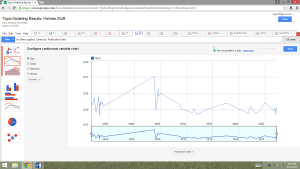The results of my topic modeling graphs were incredibly interesting to me. In my first analysis, I combined the topics of “crime,” “police work,” and “murder/death”. In this graph I found that, while the topic of police work tends to spike at random points throughout 1903-1904, crime and murder/death tends to be lower and typically the same throughout the two years in question. I did a bit of research and noticed that the two years graphed in this analysis were years of important sports events and a few protests. This would explain the spike in police activity without a correlating spike in crime.

The second graph I charted was comparing the topics of travel and time. Travel appears to spike in a dramatic increase in 1908, with time spiking upwards as well during this time. I discovered through outside research that throughout the year of 1908 travel was becoming increasingly popular: the year beings with two expeditions around the world (one specifically from New Zealand to Antarctica); the Olympics were held in London in 1908 (which would increase travel to the area); and finally, the first aircraft manufacturing company in England is found in London. This would explain the increase in travel, as well as time.

Another set of topics I compared and contrasted were Business/Commerical and Construction. I noticed in my graphs that there was a correlating increase in both topics in 9125 and I wondered why that was. Looking at outside research, I noted that in 1925 there was a great deal of economic/commercial events taking place. For instance, primogeniture (or the rule that the first born son would inherit from the father) was abolished, Britain returned to the gold standard, the government granted a subsidy to the coal industry while they investigated its issues, the first double-decker buses with covered tops were introduced, and various bridges and tunnels were constructed. These events would clearly influence the Sherlock Holmes stories, as well as explain the increasing spike of these topics in 1925.

Lastly, I decided to compare the topics of literature, description of clothing, and emotional verbs/actions. I thought that these topics were comparable as they all had to do with writing, and to an extent, education.I found the most interesting time period in this graph to look at was the years of 1891-1893. I found that literature often spiked dramatically first, and then the descriptive words would follow. One interesting fact that I discovered was that in 1891 Elementary Education was made free, allowing for an increase in literacy and education. This would, therefore, explain why the spikes were so dramatic around this time period. Futhermore, in 1892 Scottish universities began accepting women, and in 1893 the Brontë Society is established (the oldest literary society) and the Elementary Education Act raises the age to leave school to 11. All these historical events were significant in the rise of literacy and education, therefore explaining the rise of the topics of literature and the following descriptive words and actions.








